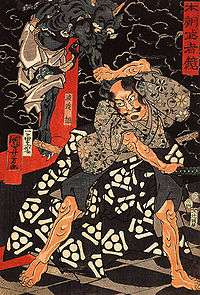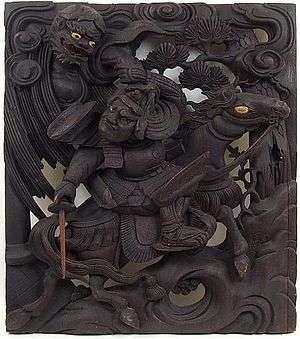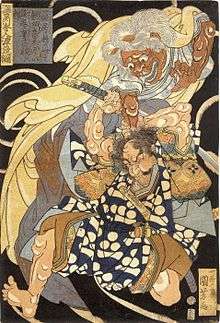Watanabe no Tsuna

Watanabe no Tsuna (渡邊 綱) (953-1025) was a Japanese samurai, a retainer of Minamoto no Yorimitsu (also known as Raikō), one of the earliest samurai to be famed for his military exploits.[1]
In legend
Watanabe features in many of Yorimitsu's legendary adventures, and aids him in fighting many monsters, beasts and demons.
In one such tale, Tsuna accompanies Raikō to the hut of Yamamba, a man-eating hag. There they find a boy known as Kaidomaru, who had been brought up among animals and endowed with superhuman strength. The boy requests that Raikō allow him to become one of his retainers, and Raikō accepts, giving the boy the name Sakata no Kintoki, often shortened to Kintoki.
Some of Watanabe no Tsuna's other comrades in legend are Urabe no Suetake and Usui Sadamitsu. Together, the four are collectively known as the Four Guardian Kings, an allusion to the Buddhist Shitennō. Watanabe is also said to have assisted Raikō in slaying a tsuchigumo.
His most famous feat is the defeat of the demon Ibaraki-doji, the principal follower of Shuten-doji. He fought Ibaraki-doji single-handedly at the Rashomon gate at the southern end of Suzaku-oji, the central North-South street in the old capital Heian-kyo (now Kyoto).
Tsuna and the Ibaraki-doji


According to legend in the late 10th century of Heian Period Japan, Ibaraki-doji, a notorious Oni, resided at Rashomon Gate in Kyoto. Ibaraki-doji harassed people who tried to pass through the gate until a heroic samurai named Watanabe no Tsuna, a loyal retainer of Minamoto no Raiko, went to subdue the creature. When Tsuna arrived at Rashomon Gate he was attacked by Ibaraki-doji. However, Tsuna was a strong and valiant swordsman who was able to defend himself against the ferocious attack. The battle raged on until Tsuna drew his katana and severed the arm of the demon. Screaming in pain Ibaraki-doji ran away from Tsuna, leaving the severed arm behind. Tsuna swept up Ibaraki-doji's arm as a trophy. When he arrived home at his mansion he wrapped up the severed arm and locked it away in a chest (唐櫃).
A few days later, an elderly woman claiming to be Tsuna's aunt, Mashiba, came to visit him. During the conversation, she aunt asked her nephew to recount how he fought with the demon, and when Tsuna mentioned that he had the severed arm in his possession, his aunt was curious and asked to see it. The unsuspecting Tsuna brought out the chest with Ibaraki-doji's arm inside and when he removed the arm, his aunt revealed herself as being Ibaraki-doji in disguise. She grabbed the arm and escaped from Tsuna's mansion. Tsuna was astonished that Ibaraki-doji had posed as his elderly aunt and did not give chase. However, even after retrieving the arm, Ibaraki-doji never returned to dwell at Rashomon Gate again.
Tsuna's Meitō, the Demon Slayer
Watanabe-no-Tsuna was armed with one of the most famous swords in early samurai History, a Tachi called Sun-Nashi (Missing Sun) of a length of 2 shaku & 7 sun (roughly 81,8 cm), forged by the great Munechika, with the help of Hachiman Daimyōjin, or so the legend says. One of the two earliest recorded swords used to perform Tameshigiri, it has changed nicknames and owners multiple times.
Among the nicknames of this sword were : Sun-Nashi, Tomokiri, Higekiri, Onikiri, Shishi no ko and Tomokiri (again).
Tomokiri (the Friend Slayer, or Equal Cutter), for having cut, by its own will, through the steel of another sword of great quality, Hizamaru, who had been made at the request of the Emperor of Japan, by a smith rival of Sun-Nashi's maker. Higekiri (beard cutter) was earned when the blade beheaded a criminal, the earliest Tameshigiri recorded, attempted in the hands of Minamoto no Mitsunaka (Raiko's father)... the victim had a long beard, who was cut smoothly along the neck. Onikiri (Demon Slayer), come from the incident of Ibaraki Dōji's severed arm. Shishi no ko (lion's cub) came from a legend where it made noise like a roaring lion at night, as if possessed by some Yōkai. And Tomokiri (again), after having by its own will (again), cut through a copy of its blade and shortened it in order to make it the same size. A similar story exist for Onimaru Kunitsuna, one of the Tenka Goken.
Heirloom of the Settsu Genji bloodline of the Minamoto Clan, treasured and used in combat by famous heroes, such as Raiko, Tsuna, Minamoto no Yoshiie and his son Tameyoshi. It was Raiko who gave Higekiri to Watanabe-no-Tsuna, trusted friend and general. Latter it was inherited by Raiko's nephew and passed on in the Settsu Genji family.
Alas, it seems that neither Hizamaru nor Onikiri exist anymore.
In popular culture
- American musician Matt Heafy, lead singer of the Heavy Metal band Trivium, Has a tattoo of Watanabe no Tsuna battling the Oni demon
- The 1985 historical fantasy novel Teito Monogatari by folklore researcher Hiroshi Aramata features a climactic scene which is a direct homage to Watanabe no Tsuna's encounter at Modoribashi bridge. In the story, Meiji era writer Koda Rohan makes a dash to stop the oni Yasunori Kato from flying away with an innocent young maiden. He grabs Kato by the legs, but is lifted up into the air with him. Desperate to free himself, Rohan slashes at Kato with his short sword and drops to the ground holding Kato's severed arm.[2] In the first film adaptation of the novel, there is a scene at the beginning where an artist at a local festival is describing the story of Watanabe no Tsuna to an audience, foreshadowing Koda's encounter with Kato. Also in the corresponding scene of this adaptation, before Kato disappears into the air, his face turns into a demonic countenance revealing his true nature.
- Watanabe no Tsuna, is a character in the anime Otogi Zoshi. Minor historical error, Tsuna's sword his already nicknamed Onikiri way before his encounter with Oni demon, Ibaraki Dōji.
- He is also a character in the anime Kai Doh Maru, where he fights the albino warrior Ibaragi, a lieutenant of the sorcerer known as Shuten Doji. In their first fight he cuts off Ibaragi's right arm; in the second Ibaragi - who shouts he's come to take back his arm - cuts off Tsuna's right arm and would have beheaded him had he not been mortally shot by Minamoto no Raiko; he has life enough left to detonate himself before dying, killing Tsuna in the process.
- Watanabe, along with Raikō, Usui Sadamitsu, Sakata no Kintoki, Urabe no Suetake, Abe no Seimei, and several other well known figures in Japanese history, is featured in the Xbox video game, Otogi 2: Immortal Warriors. In the game, he has a wolf-like appearance and wields a dual-sided curved sword.
- The main character of Ogre Slayer, a manga by Kei Kusunoki, is believed to be Watanabe no Tsuna.
In netsuke

Exciting myth about Watanabe no Tsuna was perpetuated not only in written works, but in art and sculpture. The image of Watanabe no Tsuna taking his sword to beat demon’s attack off became iconographical.
There is the netsuke, made of famous carver of the 19th century Otoman - Watanabe no Tsuna and Demon of Rashomon. This work is based on a little-known legend about the struggle of the famous samurai with a demon that turned into a young girl.
One day the chief sent samurai Watanabe no Tsuna to a village with a task. Upon fulfilling the task, Tsuna decided to return to the city as soon as possible. It was already getting dark when he approached the bridge and saw a pretty girl who asked the gallant samurai to take her home at such a late hour. He put the girl on his back and was about to move on. Suddenly the girl became a terrible devil, who grabbed Tsuna's hair and whispered: 'My house is located on Mount Atago'. The Samurai did not lose his courage, he quickly drew his sword and cut off the devil’s paw. The monster disappeared in the darkness, wailing. Tsuna picked up the trophy, but lost it on his way back home.
The carver skillfully reflected this subject in presented netsuke. The sudden devil’s attack did not take the brave warrior unexpected. With his one hand he is firmly holding the devil's wrist, and with the other hand he is pulling his sword from its sheath. The temptress’s face and body has changed beyond recognition, and only flirtatious gesture-holding to the edge of the cloak-speaks about its feminine essence.
The presented work is really unique. This is the only netsuke in the world that has master’s signature with kakihan. The story of this figure’s appearance at antique market is very interesting. In 1983 German collector Klauss Reiss purchased this netsuke as okimono for 2500 Deutsche Marks in antique saloon of Munich. The seller said that he exchanged this okimono for bronze Japanese statues. Coming home Klauss Reiss unexpectedly discovered that support of the purchased okimono could be separated from the figure. After tearing it off the collector discovered himotoshi and Otomon's signature!
When another collector Barry Davis saw this netsuke he proposed Klauss a good sum of money. The sum of the deal is not disclosed. Later the figure changed its owners several times before it got to the Ukrainian collector Borys Filatov.[3] As of 2009 this work is the most expensive netsuke at world antique market.
References
- ↑ Sato, Hiroaki (1995). Legends of the Samurai. Overlook Duckworth. pp. 61–64. ISBN 9781590207307.
- ↑ Reider, Noriko T. Japanese Demon Lore: Oni from Ancient Times to the Present Utah State University Press, 2010. 113. (ISBN 0874217938)
- ↑ Watanabe no Tsuna and Demon of Rashomon, netsuke, ivory, circa 1830
External links
 English Wikisource has original text related to this article: The Ogre of Rashomon
English Wikisource has original text related to this article: The Ogre of Rashomon- Legend and History of Shutendoji
- International Netsuke Society, official website
- Boris Filatov's Private Collection of Netsuke